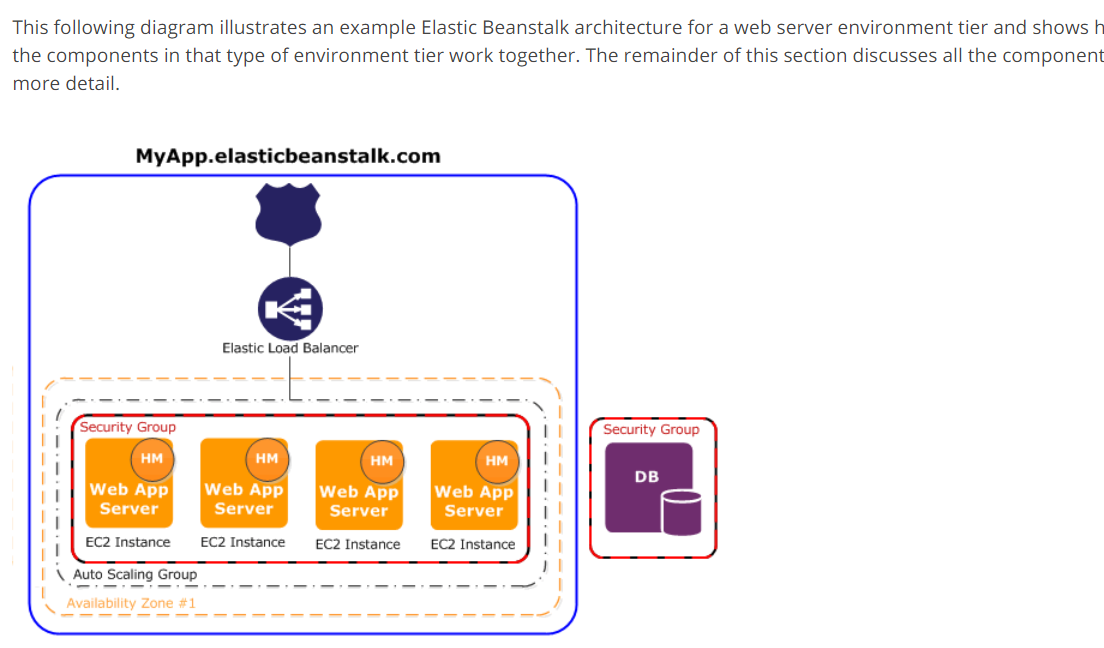Which Scenarios Warrant the Use of ElasticBeanstalk? | AWS Certified Solutions Architect - Associate Exam
Question
For which of the following scenarios should a Solutions Architect consider using ElasticBeanStalk? (Choose TWO.)
Answers
Explanations
Click on the arrows to vote for the correct answer
A. B. C. D. E.Answer - A and D.
AWS Documentation clearly mentions that the Elastic Beanstalk component can create Web Server environments and Worker environments.
The following diagram illustrates an example of Elastic Beanstalk architecture for a web server environment tier and shows how the components in that type of environment tier work together.
https://docs.aws.amazon.com/elasticbeanstalk/latest/dg/using-features-managing-env-tiers.htmlFor more information on AWS Elastic beanstalk Web server environments, please visit the URL https://docs.aws.amazon.com/elasticbeanstalk/latest/dg/concepts-webserver.html.
Option B is incorrect.
Elastcibeanstalk is used to deploy and manage the applications on AWS.
It's not used to store the data.
https://docs.aws.amazon.com/elasticbeanstalk/latest/dg/Welcome.html.For more information on AWS Elastic beanstalk Worker environments, please visit the following URL: https://docs.aws.amazon.com/elasticbeanstalk/latest/dg/concepts-worker.html.
Option C is incorrect.
OpsWorks is more suitable when Chef is used to configure AWS resources.
Option D is correct.
The worker environments in Elastic Beanstalk include an Auto Scaling group and an SQS queue.
This option is suitable.
Option E is incorrect.
When you launch an Elastic Beanstalk environment, you first choose an environment tier.
The environment tier that you choose determines whether Elastic Beanstalk provisions resources to support an application that handles HTTP requests or an application that pulls tasks from a queue.
An application that serves HTTP requests runs in a web server environment.
An environment that pulls tasks from an Amazon Simple Queue Service queue runs in a worker environment.
Further, when you create an environment, Elastic Beanstalk provisions the resources required to run your application.
AWS resources created for an environment include one elastic load balancer (ELB in the diagram), an Auto Scaling group, and one or more Amazon EC2 instances.
So, these resources must run the application 24/7, not for only at night or day.

Elastic Beanstalk is a fully-managed service provided by AWS that makes it easy to deploy and run applications in multiple programming languages, including Java, .NET, Node.js, PHP, Python, Ruby, and Go. It handles deployment, capacity provisioning, load balancing, and automatic scaling, allowing developers to focus on writing code without worrying about infrastructure.
A Solutions Architect should consider using Elastic Beanstalk for the following scenarios:
A. A Java web application using Amazon Linux EC2 instances Elastic Beanstalk is an ideal choice for deploying and managing web applications built using Java programming language. It simplifies the process of deploying and scaling web applications by automatically provisioning and configuring the underlying Amazon EC2 instances, load balancers, and other AWS services.
D. A worker environment with an SQS queue and an Auto Scaling group Elastic Beanstalk can also be used to manage worker environments that process tasks in the background. In this scenario, Elastic Beanstalk can be used to deploy worker instances that listen to a SQS queue and automatically scale the number of instances based on the number of messages in the queue. This ensures that the workload is evenly distributed and the system can handle large volumes of work efficiently.
The other options are not suitable for Elastic Beanstalk:
B. An Enterprise Data Warehouse Elastic Beanstalk is not designed for deploying and managing data warehousing solutions. Data warehousing requires specialized infrastructure and configuration that is better handled by AWS services such as Amazon Redshift or Amazon EMR.
C. Configuring AWS resources using Chef Chef is a popular configuration management tool that can be used to automate the deployment and management of AWS resources. However, Elastic Beanstalk is a higher-level service that abstracts away the details of managing infrastructure, and therefore is not suitable for use with Chef.
E. A management task run once on nightly basis. Elastic Beanstalk is designed for running web applications and background workers that need to be available all the time. Running a management task once a night is better suited to AWS Lambda or AWS Batch, which are serverless computing services that allow you to run code without having to provision or manage servers.